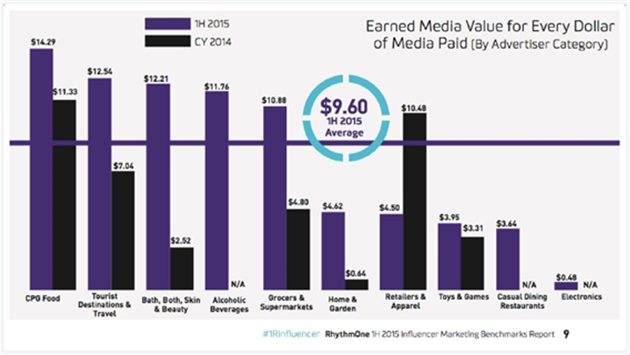Influencer marketing has been around for a few years, but with the current level of media coverage and discussion around it, it is fair to say that 2016 marks its growth inflection point.
No longer are marketers asking, "What's influencer marketing?" Today, many are asking, "Should we develop an influencer marketing channel?" or, "How much effort and budget should we put behind it this year?"
Embracing something new, regardless of how advantageous it might be, is difficult. It's change, and change in an organization is rarely a simple or efficient process. (I remember when we changed coffee suppliers; you'd think we were cutting salaries in half.)
Part of the resistance to doing anything more than experimenting with influencer marketing is the idea that it is simply a fad and support for it will fade. Marketers can be cynical by nature, and they have seen their share of new ideas come and go, so that is a fair concern. Why will influencer marketing be different? The answer rests in the dynamics that have made it so popular in the first place: Consumers are disengaged with traditional marketing practices, and they prefer to communicate with each other.
Consider:
- A Nielsen study found that 92% trust the opinions of people they don't know over the assertions of brands.
- Sprout Social discovered that 71% of people turn to their social networks for pre-purchase guidance.
- A 2015 report by Adobe and PageFair found that US ad blocking grew 48% in the 12 months preceding June 2015, and there are now nearly 200 million adblock users around the world.
Moreover, the market is past the point of early adoption: Brands already vested in influencer marketing are achieving results, even more than what their own marketing channels are delivering. For example, Maybelline's company-run YouTube channel drives 11,000 views per video, whereas videos created by influencers for Maybelline generate an average of 1.4 million views per video.
With these hard-to-ignore results, and the mounting challenge of reaching consumers who are blocking ads and cutting cords with great enthusiasm, it's no wonder more brand marketers are looking to shift more resources to influencer campaigns.
The problem is, not everyone in the organization may be sold on embracing influencer marketing on a large scale, at least not quite yet.
The following three tips should help you build an internal support for an aggressive and sustained influencer marketing strategy.
1. Help the C-suite find budget
Influencer marketing is a big shift in digital marketing. For starters, it will require budget, either an increase in overall marketing spend or money from another line item. And getting new budget approved can be an arduous process.
We all know what executives are interested in: growth, revenue, and returns. Many executives still think of Marketing as a cost center. You'll be asked to justify the spend and prove why it makes sense to invest in a new area.
So how do you convince the C-suite that you need yet another marketing channel, or even make a case for allocating budget for some starter influencer marketing campaigns? Start with the CFO and present near-term and long-time financial benefits, including analytics that show how other digital marketing efforts are trending downward while engagement with influencer content is on the rise.
A powerful financial stat worth touting comes from a

Also compelling: Branderati discovered that a 12% increase in brand advocacy generates, on average, a twofold increase in revenue growth rate and boosts market share.
If possible, conduct a couple of initial test campaigns before meeting with the C-suite to demonstrate that influencer marketing is effective for your brand and deserves room in the budget.
Or, if you don't have the resources to test, present case studies from your competitors that have achieved measurable results.
2. Assess team skills and discuss openly
A new practice also means new and different roles on the team. Is the right talent available in-house? Will people be reassigned? Will there be changes to the current structure?
This is one of the more difficult areas to handle, and the best approach is to be as transparent as possible. If you don't know what the ramifications are going to be, be honest in telling the team that you're working through it.
In reality, the use of influencers is often an excellent way to augment the existing team with little upheaval. For example, two of the top content challenges facing companies are producing enough content and producing engaging content, according to research by MarketingProfs and Content Marketing Institute. It is more efficient to address those challenges by using influencers than building a newsroom in the marketing department.
Lack of visibility into the process is a major productivity killer for the team: If they spend more time wondering what's going to happen than focused on their work, no one wins. Update them during your weekly meetings as you learn what structure might work best for your team situation. You may even discover through the process that certain team members have skills that lend themselves to managing campaigns or influencer relationships.
3. Release messaging control
The biggest challenge you'll face internally with influencer marketing is that it takes the messaging out of Marketing's control. Traditionally, Marketing took time to craft precise messages it wanted to put in front of people. That approach no longer works. Conversations happen in real time, and consumers expect brands to participate in a natural and authentic way.
The best way to engage consumers today is via the people they already trust. Branded messaging has its place, but increasingly the content that is going to move the needle on sales comes from influencers. This means taking a step back and relinquishing some control.
Overly manufactured influencer content will be seen exactly as what it is, whereas people are drawn to influencers because they have their own style and tone; even their spelling and grammar mistakes make them more "human" and likeable for their followers.''
The best piece of advice for building a successful influencer practice is that you find the right influencers to work with... and then let them create messaging in their own voice. Don't ask or expect them to use your messages verbatim, and don't critique their style of writing.
Give them permission to be themselves, and you'll even find that they'll start to adopt more of your brand voice over time.




